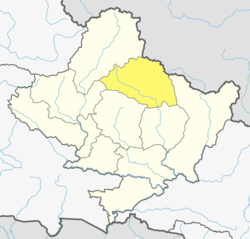Manang District
मनाङ | |
|---|---|
 Annapurna, Manang District | |
 Location of Manang (dark yellow) in Gandaki Province | |
| Country | |
| Province | Gandaki Province |
| Admin HQ. | Chame |
| Former HQ. | Thoche |
| Government | |
| • Type | Coordination committee |
| • Body | DCC, Manang |
| Area | |
• Total | 2,246 km2 (867 sq mi) |
| Population (2011) | |
• Total | 6,538 |
| • Density | 2.9/km2 (7.5/sq mi) |
| Time zone | UTC+05:45 (NPT) |
| Telephone Code | 066 |
| Website | ddcmanang |
Manang District (Nepali: मनाङ जिल्ला , in Gandaki Province, is one of the seventy-seven districts of Nepal. The district, with Chame as its district headquarters, covers an area of 2,246 km2 (867 sq mi) and in 2011 had a population of 6,538.[1]
The Thorung La pass, at 5,415 meters above sea level, connects the district with Mustang district by providing a route between the towns of Manang and Muktinath. Manang district gets the lowest amount of rainfall among the districts of Nepal as it lies to the north of the Himalayas, which block monsoon winds. The Manang Valley, which lies close to the Nepal-Tibet border, offers tremendous opportunities due to its rich natural flora and fauna. Three tracks start from here. The first, via Thorangla, Muktinath, and Mustang to Lhasa—a journey that takes four days; the second via Naur Khola and Naurgaon, which takes five days to Lhasa; and the third via Larkiya bazar, which is the one most commonly used by the people of Central Nepal.
Along with the Marwaris who have migrated from India to Nepal in large numbers, the Manangies are the best known traders of Nepal. They have received special dispensation from the King to trade in South East Asia, and travel abroad with precious stones and metals, musk, herbs and other items. They import ready-made garments, watches and electronic goods. Many of the Manangies spend as much as six months away from home, returning only during the summers. Many of them reside in Kathmandu, where their children study in English-medium schools. The parents' lack of proficiency in the English language is irrelevant as it in no way affects their trading skills.[citation needed]
Since the area was opened to outsiders in the late 1970s, many have switched from the traditional agriculture to hoteleering.
The trail from Manang to Muktinath has been used by the locals for hundreds of years to transport huge herds of sheep and yak in and out of Manang. It is an important route for the people of the region.
The northern parts of Manang Valley are dry, brown and desolate places, very different from the thick forests and brown green valleys of Sikkim and Eastern Nepal.

- ^ "National Population and Housing Census 2011 (National Report)" (PDF). Central Bureau of Statistics. Archived from the original (PDF) on 2013-04-18. Retrieved 2015-06-01.